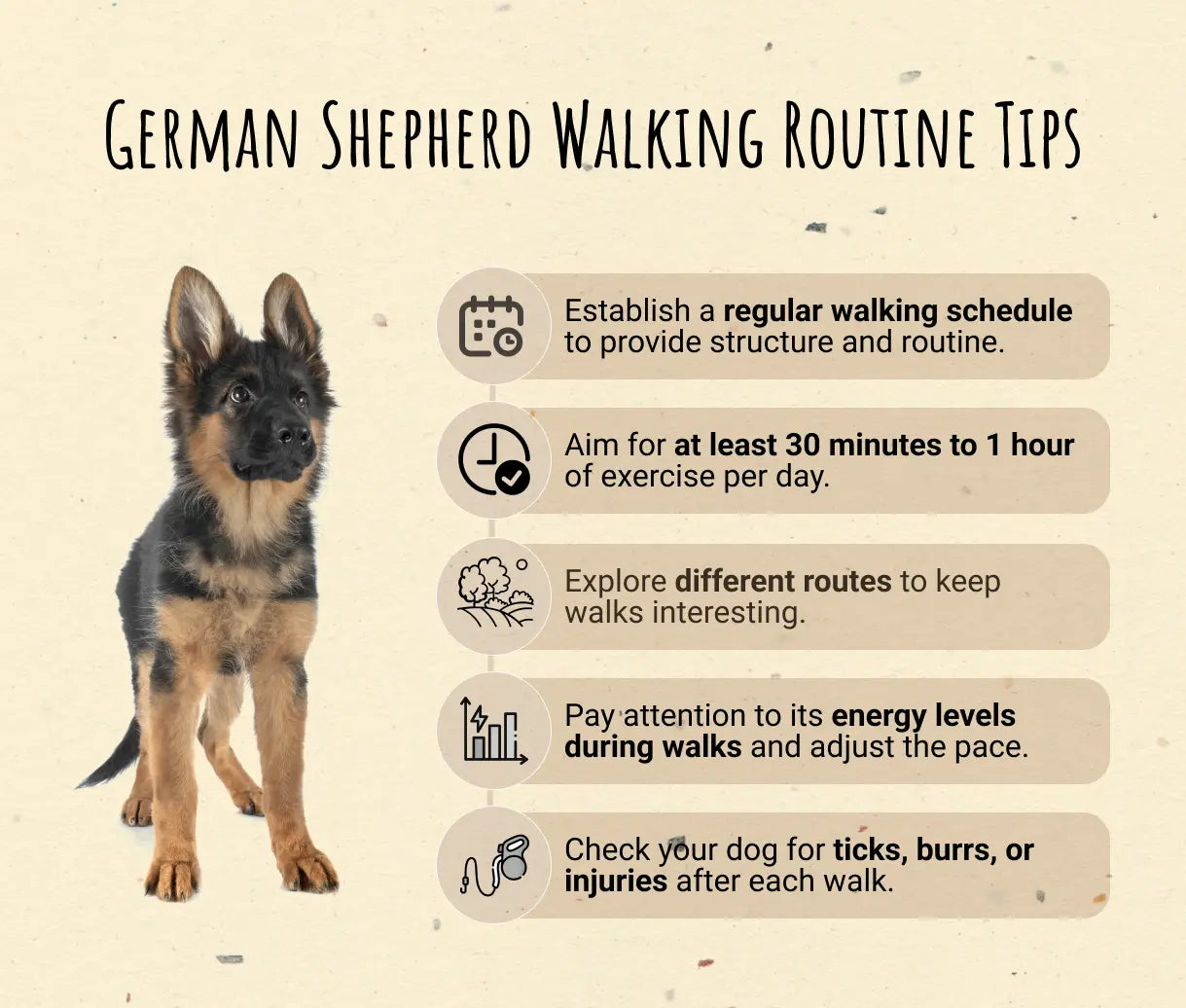Having a pet dog is an excellent source of joy. The happy barks and waggy tails are all a dog parent needs after a long day of work. But being a dog parent comes with many responsibilities. After all, Fido has its own physical and mental well-being needs. Besides feeding the furry friends, keeping them hydrated, and taking them to their yearly veterinary check-ups, these responsibilities include establishing a well-planned dog exercise routine.
Whether you're the parent of a tiny puppy dog or one of an aging one, you'll always have questions of hows and whats when it comes to walking your canine. If you're looking for tips on how to walk your dog, we've got you covered.
Understanding Your Dog's Needs
Breed-Specific Requirements
Working dogs into a new exercise routine requires a lot of research and asking around. One of the main factors you should consider when figuring out how much walking and running around a dog needs each day is the breed. Working and sporting dogs, for example, need a great deal of exercise during the day. We're talking about breeds like German Shepherds, Border Collies, Siberian Huskies, Weimaraners, and Golden Retrievers.

Contrary to the more active breeds, small lap dogs like Shih Tzus, Pomeranians, Pugs, and Yorkshires can be happy with shorter walks. It's true that certain breeds lead a more active life than others. But it's not the only factor that you should consider when planning a dog exercise routine. Many other factors also come into play. These include age, individual energy levels, and health considerations, all of which we'll be covering next.
Age Considerations
A dog's daily schedule chart varies depending on its age. Younger dogs up to five tend to exercise more than their adult and senior counterparts. It's worth mentioning that dogs aged from five to eight are considered adults, whereas those aged nine and above are seniors.
Younger dogs usually have more energy and fewer health problems. The older a dog gets, the higher the chances of developing health problems like arthritis, atrophy, or diabetes - which can slow down even the most energetic canines. So, even if older dogs would love to take a longer walk, chances are their bodies won't allow them to go too far. Keep their physical strength in mind before taking them on long walks.
Recognizing Individual Energy Levels
Even though breed and age play a significant role in how much a dog can and needs to exercise, they are not the only factors you should account for. While planning your dog's exercise routine, your canine companion's energy level must be examined. Two dogs of the same breed and age can have different exercise tolerance levels. That's why paying close attention to what Fido is communicating with you is crucial.
Pacing, jumping, and overall restlessness usually indicate that your dog is very energetic, while lack of enthusiasm, reluctance to move, and excessive sleeping indicate that you've got a passive pooch. Consider basing your dog's exercise routine on its particular energy level and building from there.
Health Considerations
While some dogs are naturally hyperactive and others are not, health conditions can also affect their energy levels and ability to take long walks. Certain dog breeds can easily go on long hikes with their owners if they're healthy enough. We're talking two-plus hours of walking. But dogs with health conditions like diabetes or obesity will have a more challenging time keeping up.
If your furry friend suffers from a health condition, it's best to start with a gentle exercise routine for dogs and advance slowly with the help of a veterinarian. Keep in mind that even dogs with health conditions need exercise.
Living Spaces
Your living spaces majorly affect how frequently your dog needs to exercise in a day. If you live in a small apartment, let's say your dog will need to explore the outside world more often than a dog who lives in a house with a huge backyard.
A wide open space in the front or back of your house allows your pup to exercise without troubling you with a walk every few hours. But if you don't have the luxury of a big yard, you'll need to plan a dog daily schedule chart around the fact that your little friend hasn't had the chance to get those muscles moving enough during the day.
Planning Your Dog Walking Schedule
Build a Schedule Around Your Dog's Needs
The most important part of planning your dog's exercise routine is its physical and mental needs. That is to say, a Boxer dog exercise routine shouldn't look the same as that of a Chow Chow, nor should a young puppy's routine look the same as an elderly dog's routine.
As discussed above, you'll want to factor in breed, age, energy level, health condition, and living space. While these are not the only things you should consider, they're good starting points for laying out a daily exercise routine for dogs.
Related: Exercising Senior Dogs for Optimal Well-Being - Tailored Tips
Understand Your Pup's Preferences
Dogs are often very opinionated. They have opinions about their foods, snacks, toys, and even their walking routes. You'll want to listen to what your four-legged friend is trying to communicate, especially since exercise is essential to their day.
You may have a dog that enjoys a single long walk in the mornings or would rather go on multiple short walks throughout the day. If you don't understand these preferences, you might end up with a super hyper dog at home or one panting loudly halfway through the route. At the same time, some dogs will prefer certain areas over others. And if your dog likes that one beachside trail over the park, let's say, then beachside trail it is.
Check Your Schedule
Of course, you can't forget about your daily schedule while planning your dog's exercise routine. Your pup does have needs and preferences, but what if the routine doesn't fit your schedule? Unless you have a dog walker or a pet sitter you can trust, you must build a routine that covers your dog's needs without compromising your day.
If you have more time in the morning to spend with your furry friend, for example, then you can save that time for the longest walk of the day. But if your evenings are a better option, you can have some good playtime later in the day. It's all about striking a balance that suits both Fido and you.
Location Matters
Stick to a Routine Path
While it's not absolutely essential for dogs to walk in familiar places, having a path they know well as their daily workout path can be a good idea. Familiar surroundings give your dog a sense of security and comfort, which prevents stress and anxiety. They can also allow your dog to enjoy its walk without being overwhelmed by new sights, sounds, and smells.
An added benefit of your dog having a routine path is that it'll be easier for them to pee and poop in an area they're familiar with and one that they've marked as their own. A familiar path with familiar scents and sounds helps when planning to walk a blind dog.
Change the Scenery
While sticking to a routine path has benefits, you can't go wrong with changing the scenery occasionally. Now and then, your dog needs to explore new places and paths - as long as they're perfectly safe. This will allow for mental and sensory stimulation as well as enrichment. Plus, new routes and spots mean you won't have to see the same spots repeatedly.
Try going for a morning run on the beach, exploring the woods, or viewing the houses in the neighborhood next to yours. Spicing up your dog's exercise routine is beneficial for both of you. You'll eventually have three or four paths to switch between once a month or so.
Search for Friends
It doesn't hurt for your dog to have some company on its daily dog exercise routines. Dogs are social animals, and where their canine friends are is where they'd like to be. That said, try walking your dog on paths popular with other dog parents or towards a dog-friendly park nearby.
This way, Fido will not only get its daily dose of exercise but will also play, socialize, and make friends with fellow dogs. But remember that while most dogs like socializing, not all do. With that in mind, make sure to familiarize yourself with your furry friend's preferences before you engage them in social activities.
To Sum Up
Regardless of breed, age, and health conditions, all dogs need some form of physical activity to stay mentally and physically stimulated. As a dog parent, do some research about the canine you're responsible for - and get to know its needs and preferences. Also, check your schedule to see how much time you can allocate to executing a good dog exercise routine.
Taking care of a dog is no easy task. Dogs deserve parents who have enough time to keep them healthy and happy. Because guess what? Believe it or not, dogs love to keep their human parents happy, too. And if you invest your time and efforts into them, they will return the favor and some more. Ultimately, knowing how to walk your puppy is a win-win situation.














Leave a comment
This site is protected by reCAPTCHA and the Google Privacy Policy and Terms of Service apply.